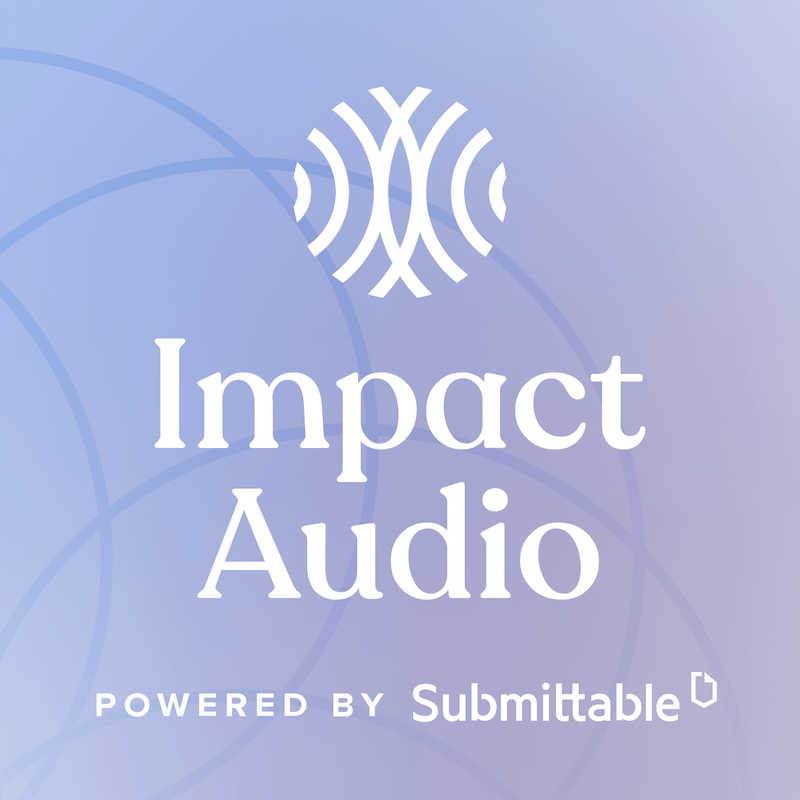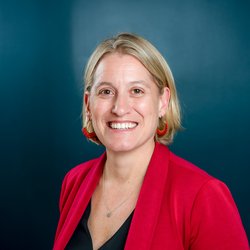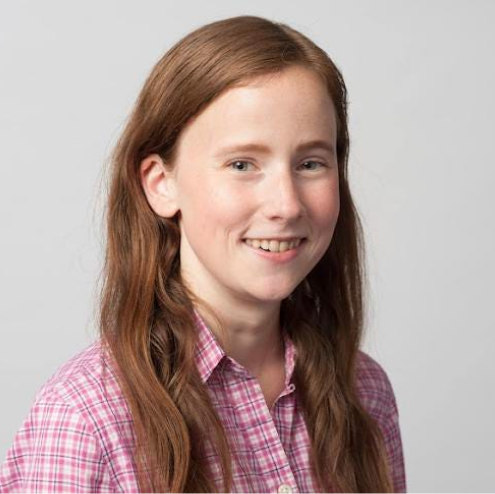< Back to all episodes
Carmen Perez and Sam Caplan
What is the ‘S’ in ESG, and how do you measure it?
This episode of Impact Audio features Carmen Perez, founder and partner at Better Next, on how to measure the impact of CSR and grantmaking programs.

What is the ‘S’ in ESG, and how do you measure it?
Carmen Perez, founder and partner at Better Next, and Sam Caplan tackle one of the trickiest aspects of CSR and grantmaking—measuring impact.
Description:
The ‘S’ in ESG encompasses everything from DEI initiatives to community investment programs and employee volunteering. For social impact practitioners, the big question is how you measure the impact of this work. Carmen Perez has spent her career helping teams get clarity about the short and long-term outcomes they want to achieve.
This episode digs into how to:
Build the right measurement frameworks for your team
Understand the nuances of outputs versus outcomes
Capture the complexities of social impact
Leverage the data you already have
Guests:

Carmen Perez
Carmen Perez is founder and partner of Better Next, serving as an advisor and leader of social impact special projects for more than 100 multinational corporations. She built her reputation on her extraordinary expertise in measurement, pioneering new methodologies and metrics for measuring social impact.

Sam Caplan
Sam Caplan is the Vice President of Social Impact at Submittable, a platform that foundations, governments, nonprofits, and other changemakers use to launch, manage, and measure impactful granting and CSR programs. Inspired by the amazing work performed by practitioners of all stripes, Sam strives to help them achieve their missions through better, more effective software.
Sam formerly served as founder of New Spark Strategy, Chief Information Officer at the Walton Family Foundation, and head of technology at the Walmart Foundation. He consults, advises, and writes on social impact technology, strategy, and innovation.
Connect with or follow Sam on Linkedin, listen to his podcast Impact Audio, and subscribe to his bi-weekly newsletter The Review.
Transcript:
Episode notes:
Follow Carmen on LinkedIn
Explore Better Next
Get a primer on ESG
Learn more about stakeholder capitalism
Take a deep dive into social impact measurement
Dig into Submittable’s reporting capabilities
Check out the IFRS
Explore the Better Next measurement framework
Learn about Gantt charts
Read about Levi Strauss & Co.’s ESG
The investor reporting tools Carmen mentions:
SAM CAPLAN: Imagine you're in a dark cave with a small flashlight. All you can see is a little circle of light. And the only way to figure out what the cave really looks like is to piece it together in your head.
You have to add up all those little circles of light until you get a decent idea of where you are and where you're going. This is how measuring social impact can sometimes feel, like you only get a bunch of tiny glimpses, and you have to figure out how they all fit together and what to do about it. Carmen Perez is working to fix this to help social impact practitioners light the way to more equitable impactful programs.
[MUSIC PLAYING]
Welcome to Impact Audio. I’m your host, Sam Caplan, VP of Social Impact at Submittable. This episode originally aired as part of our Impact Studio Conference in 2022. Our 2023 conference is coming this September. Go to Submittable.com/impact to learn more.
Last October we sat down with Carmen Perez, an ESG consultant and founder and partner at Better Next. She broke down her approach to social impact measurement and what it means to quantify the outcomes of your work.
Before we get into the deeper conversation around measurement, I think it’s really important to take a moment to define some of the language we’ll use. Corporate purpose is having a real moment right now, which is great. But sometimes buzzwords get tossed around so much they start to lose their meaning. Plus, before you measure anything, you have to define it.
CARMEN PEREZ: Currently, ESG is in vogue as sort of the holistic term, encompassing a lot of different strategies, a lot of different issues, and actions that a company might be taking. And then CSR is an older term, but I think still used by many companies. And it's a subset of that larger, more holistic strategy.
So parallels to ESG might be sustainability, or now, I think stakeholder capitalism is sort of that similar sort of holistic term. And then CSR parallels, I think, could be as an ESG or social impact. Citizenship and responsibility are probably a little bit less more commonly used now, but to me, it's about that bigger-picture strategy and then the subset, which is where I have lived most of my career in that S in the ESG world.
SAM CAPLAN: When it comes to measuring the S in ESG, part of the complexity lies in how much ground that one letter covers. The social of environmental, social, and governance can represent all sorts of societal issues, including labor standards, human rights, pay equity, workplace diversity, and community investments. That's a whole lot for one team or one person to hold. Understanding the breadth of what's possible will help you zero in on what's important for you and your team.
CARMEN PEREZ: Companies that are being strategic about the way they think about this work begin with materiality or sort of identifying their critical issues for all of their stakeholders, not limited to investors. Then within these broad brush stroke categories, they're saying what's really important for our business and the people who are affected by our business.
So diversity, equity, and inclusion, human rights, labor relations, training, health and safety, all of those things are within the S. And I would say that social impact teams often start with a specific focus on communities. So the long-standing activities there are philanthropic volunteering and then sort of driving other business changes, which with sort of social impact thinking connected to those. And that is the S in ESG.
Companies have to make choices about which issues they want to tackle, but it is broad. I think the good news is that health and safety teams have existed inside companies for a really long time. There's people within the people department or human resources department, who have thought about diversity, inclusion, and culture for a really long time. So it's rare that one team is tackling the full S in ESG. They have to work together, but they are set up in an organizational structure, in most cases, to sort of be aligned to different issues and activities that the company might need them to cover.
SAM CAPLAN: Impact measurement is all about balance. You want to measure outcomes, but you don't want to pull too much time and energy away from the work that goes into achieving those outcomes. It can feel like you're walking a tightrope. You don't want to risk relationships with communities, simply for the sake of measurement. Every company has their own unique approach to finding this balance between trusting organizations to do the work and gathering data to measure their impact.
CARMEN PEREZ: There are still companies, who have always been extremely flexible in what they allow their partners to report. And they've just sort of said we're going to keep on doing this and have maintained that. I think there's another group that decided that they wanted more data and very specific data. They said, this is what we want, and they just continue with that in a little bit more of a transactional way.
And then I think there's another group of companies that have probably had some ups and downs, didn't have anything prescriptive, went extremely prescriptive, and then have dialed it back. Because this moment in time, certainly, the people inside companies who are leading social impact programs are probably some of the most highly aware of the moment in time we're in in terms of reckoning with some of, at least in the United States, major long-term systemic issues like racism, in particular, over the past couple of years. So this idea of rethinking decisions that might have been made is-- measurement is not sort of immune to that.
So that's kind of one sort of overarching comment that I do think that there is signals that the power balance for some companies is leaning in the direction of not just listening. But then once you hear something from a partner actually making some changes, even within any company where that's most important is in the relationships, which are of the depth that require sort of more time on the part of both partners to really make sure that they're on the same page. In my opinion, measurement is about learning and sort of uncovering new information about issues and how things are changing.
And so when you take the time to look into social impacts data, you can really sort of find new pathways to take and when you spend the time on that, because there's no one right now who wouldn't say that their most precious asset is their time. So that is for those relationships where, if I had to sort of throw a dart at the number, let's say it's 50,000 and above, and when I say depth, it's not just dollars but also time, where you're really going to say we want to hear from you, boots on the ground organization, what are you observing? What is your data telling you? How is that affecting your programmatic decisions? How is that realigning your strategy, if at all?
And so that, I think, is where the most exciting changes are happening, is when it's those deeper relationships where a company is one of several partners that an organization might have. And they're really expressing what's happening with students, who are dropping out of their higher education experience or people who are really active in a program for workforce development, but then experience recidivism. So they-- like listening to those stories and really saying, like how can we understand what the data is telling us and then make some changes, is more likely when the relationships are really deep.
SAM CAPLAN: Effective measurement hinges on your team choosing which metrics will meaningfully connect to the outcomes you want. The good news is very few CSR or ESG teams are starting from scratch.
CARMEN PEREZ: The data is already in any company, any large company. The process has already begun. They're looking at social impact data already, and so you have to look at that starting point and say, "How can we make this better?" And there's a lot of ways that the information can get better.
I also hope that the question is really around what do we want to know, what do we want to show progress on, and what results are really meaningful for us. And then that becomes the reporting and the communication. So the reporting and the communication is going to be a percentage of what you might want to know or collect or collect data and try to draw some insights from it, followed by the reporting and the communication. And that's I think a sign that you're using measurement in a really strong and smart way because it's exploratory.
It's about learning. It's about some tracking, which is just for the team. The team wants to certain things. And then components of it are most relevant to help people understand the scale, the scale and the reach.
I think people, back to the point about outcomes, when they look at numbers which don't feel like they can understand them, like a large number of people who might have received training, to me, it's not necessarily whether that training then became a long-term career change for them. It's more about understanding more about the training itself, and how could that be compared to other programs, or how many of those participants didn't have access to the training before. And so expanding on the ways we understand that particular result, to me, can be just as meaningful as following individual people through their lives to know whether or not they actually got to their desired end results.
SAM CAPLAN: Many companies are starting to widen their lens when it comes to how they understand their impact. It's not all about the bottom line anymore. In the past, shareholders or people with the financial stake in the company were often the sole focus. But now, companies are thinking more expansively and focusing on all stakeholders, that is everyone impacted by the company's work.
This includes investors but also employees and community members. the environment, and every person along the supply chain. Though there's some fresh nuance to reporting that honors this new understanding of stakeholder, investors still play a key role in setting expectations around reporting.
CARMEN PEREZ: The development of S in ESG data that you could find in a Bloomberg Terminal or Thomson Reuters or MSCI, all of them, the social data that's there is driven primarily by what companies are reporting. So their investors aren't making requests. Investors end up looking at what is it that companies are publishing in their annual sustainability corporate responsibility integrated, whatever, type of report they might be using.
So investors tend to have really strong voice, like this is useful for us. This is not useful. We can't compare this. So those voices are all really strong when it comes to the S in ESG data.
And one observation I've made specifically about investors is that when I looked at what the IFRS, which is that global body working on this, what will be, a global standard when it comes to certain components of non-financial reporting, the social pieces were fairly absent. It was primarily focused on environmental topics, the disclosure draft they have out recently. So what does that tell us, is that while investors might want this data, they may not know exactly what to ask for.
I believe we're moving into an era where companies have to make individualized choices about their reporting. There's a lot of guidance available that they could draw upon. But it's going to be complicated. It's going to be a little bit messy, and it should be, before it's standardized.
And investors are looking at something which is systematic, in particular, the communities piece, the diversity, equity, and inclusion piece, the human rights piece. I think some of the health and safety stuff is fairly well entrenched. Labor relations has got a really long history in terms of the type of information people want on that. So the communities data, I think, is probably where there is the most opportunity and room to grow.
So that was mostly commentary about investors. I would say that, in particular, for S in ESG data, because the units of measure that people are grappling towards are not well understood by investors, they must be informed by, in particular, communities. And they should be easily understood by employees and customers.
Because those very human-oriented issues, which show up in S in ESG data, in particular, on the community side, have to be accessible to the people who want to know. What is the company doing about-- you've got a big program saying you're trying to tackle and support people recovering from addiction, but show me something. You said you were going to invest $500 million in racial equity, but I need to know what. It's not just about the money. It's more the other stakeholders are interested in what happened after the money was transacted.
KERIANN STRICKLAND:
Hi there, this is Keriann from Submittable. This September we’re hosting our annual Impact Studio event, which brings together social impact and CSR experts from around the world. At last year’s event, people at every stage of their career found value in both the content and the connections they made. We’re excited to be hosting again. This year we’re focused on the future of CSR and how the work we do today ladders up to a bigger vision. You can register now at submittable.com/impact. Now back to the episode.
SAM CAPLAN: For many organizations, that's the crux, understanding what happens after the resources are delivered. Are they making a meaningful impact? The tough part is that shifting from ideation to implementation can feel like a big jump.
You might know what you want to know. But the question is, how do you get there? Confronting the practicalities and logistics of data collection and reporting can be overwhelming. The key is setting goals and making plans that are achievable.
CARMEN PEREZ: I love to think really big thoughts and have dreams and visions of this positive future, but I'm also an extremely practical person. So the type of work I like to do is grounded, and like operations and really getting things done. So I'm actually gearing up to release the Better Next measurement framework, and it's free for download.
The way that I summarize practical steps are that people should assess pipelines and practices in order to plan for one year of progress. So pipelines are the infrastructure of your social impact measurement, your definitions, your collection methods, your single source of truth, or your finals, your network of people helping you with that. And then your practices relate to a whole slew of best practices.
I'm particularly passionate about everyone taking a pause on how we think about improving measurement in order to make it even more human centered, so bringing the inclusivity and reducing inequities thinking, which are common now, in so many companies' sort of way that they want to move forward and applying it to measurement. So after that assessment, then you have to prioritize.
So you might pick two or three things that you want to undertake over the next year. That could be revising a survey that you use many times. That could be updating the final report in your software to allow for more flexibility for organizations to report their outcomes. That could be identifying a more diverse group of individuals to discuss social impact outcomes on a regular basis, quarterly or whatever that looks like.
So once those-- once the priority ways that you've found opportunities for improvement are there, making that plan is crucial. So emphasizing there's people out there who love project management. They love those Gantt charts. They love all those new softwares, where you can have cards and flips and like connecting lines and everything. So measurement needs that.
Once you know what you want to do, you have to make a plan around it, assign owners and deadlines to kind of make it happen. So continuous improvement is the name of the game. A lot of measurement people say that, and I think the reason is because there's never, maybe never isn't the right word. The idea of wiping the slate clean and starting completely fresh is highly unrealistic for most companies. And so you have to look at where you are, identify a few low-hanging fruit to get better, and then make sure you and others on the team and with partners sort of put in the elbow grease to make it happen.
SAM CAPLAN: Effective impact to measurement often focuses on outcomes over outputs. But chasing specific outcomes can sometimes obscure other more important measures of success.
CARMEN PEREZ: I have many observations on the topic of striving for outcomes. I should say that at the outset. So one is that the struggle is real.
And when you look at a struggle, you can say two different things. One is let's keep going. We're going to figure this out. And another is, are we working on the right problem?
So I say that because when I see bright spots in terms of measuring outcomes, they're localized and they're individualized. So it's about an organization, not a company, but an organization looking at their results and being able to identify how they're driving change and then sharing those learnings with all of their partners, which includes companies. In the case of companies, where I see bright spots and outcomes, like an example comes from Levi's, which does a really amazing program in their supply chain around worker well-being. Squarely supply chain oriented, very much S in ESG types of work.
And the way they've measured their outcomes, it's clear in their reporting. They don't necessarily share all of it externally. But they-- it's not about it being standardized. It's about it being specific to what their particular program to make some social change might be driving.
And so the reason that I'm mentioning how important it is that they're individualized or localized is that it's not always right to measure outcomes. Companies shouldn't always be striving for outcomes in their measurement. That isn't the only way to improve a measurement practice.
And so while it's really great, I think it's wonderful the amount of knowledge that's now in the corporate social impact sector around like logic model thinking as a tool for strategy and measurement. I almost wonder if it's become too much part of the vernacular, where some of the nuance around how the logic model both for strategy and for measurement could be used has gotten a little bit watered down.
SAM CAPLAN: When it comes to social impact measurement, there's a lot of work happening around standardization. Of course, there's some power in creating standards that we can all measure ourselves against, but there's also a risk in standardizing some parts of the work. The most effective approach is likely a middle ground.
CARMEN PEREZ: So standardization, to me, there is something so powerful about benchmarking and comparison. Someone immediately will understand your number, even if they don't understand the issue. So that might be a comparison to the previous year, the comparison to another company or another program. So I think that that is so important.
So where I think I have a fork in the road that other measurement professionals might not agree with me is that I think the standardization should remain when the unit of measure is commonly understood. So it's monetary. It's time. It's number of people. It's anything physical, so trees, books, lamps, houses.
All of those things can be standardized and are really feasible to standardize. Standardizing someone who-- longevity in a job or improved education level or happiness, I think all of those things can be identified and studied in these individualized evaluations. But I do not believe that more effort around standardizing, the results and the impact end of the equation is a good use of time, resources, and energy.
So the reason for that is that I don't actually believe the systems are set up to allow for that standardization. A lot of social impact data of that level is captured through a survey or through an interview or through a focus group. And with that level of subjectivity on the individual data side, it makes it really difficult to think about standardizing the changes that are occurring. And similarly, there is no central database.
Like right now, if you want to compare, I mentioned a GRE, a GRE score, there's a place you can go and a set of standards around understanding that number and comparing it. And there isn't a centralized database right now for-- which needs to be public, I should mention, in the public domain around changes that are occurring data. So I feel that putting efforts around standardizing, that which is already ready to be standardized, is where the greatest positive result can come.
SAM CAPLAN: The lesson here is that impact measurement doesn't happen in a vacuum. It's part of a system built to make change. And so, you always need to think about how your measurement strategy not only tracks the outcomes you care about, but also how it fits into bigger conversations around equity and inclusion.
Let's bring back our metaphor. Say impact measurement is a dark cave. No matter how bright your flashlight is, you can still get lost within its twists and turns. You need to be tethered to someone on the outside, who can keep you connected to the context in which this cave or impact measurement resides.
This person on the outside of the cave might be a community member or might be a leader of another organization. There are people who can help you keep sight of why you went into the cave in the first place.
CARMEN PEREZ: My motto is really, make progress don't require perfection. So measurement is part of the system. And it, in some ways, has probably helped sustain inequities.
So let's take the first thing we spoke about, which was related to outcomes. The idea that you have to prove an outcome, who was the first person to ask a nonprofit to prove their outcome and why. So on one hand, it could be positive intent, and like, we really want to get at the right solution. We want to put our funding and all of our resources and power behind the best solution. It could also be that that was intended to slow down progress and not allow money to flow, unless someone could show proof.
And so, to me, that's a way that measurement could have perpetuated inequities. And so, all of that to say-- this is me thinking on my more philosophical level and less on the practical level-- we need more inclusive practices. We need more equitable hiring practices and equitable access to proposals and contracts and all of that. I think that's very true.
I-- in my-- I try to always focus on what can I do. And so, for me, when I start talking about a new measurement framework that I want to be a part of putting forth in the world, I really want to think hard about measurement for the future, which is about learning, which is really focused on what a community would want to know about its community, like that internal view of learning. And in that way, I think I can contribute to making things better.
SAM CAPLAN: Thanks for listening. We hope this episode helps you center people in your impact measurement strategy. To hear more conversations like this, be sure to subscribe to Impact Audio. And join us for our Impact Studio Conference this September. Check it out at Submittable.com/impact. Until next time.
Additional Resources
Season 3 , Episode 6| 30:03 Min
The challenge model: How to flip the philanthropy script

Kristen Molyneaux

Sam Caplan
Season 3 , Episode 4| 29:42 Min
What the data says about the future of social impact

Kari Niedfeldt-Thomas

Sam Caplan
Season 3 , Episode 1| 30 Min
Lessons from the Future of CSR and Corporate Volunteering

Jen Carter

Sam Caplan








